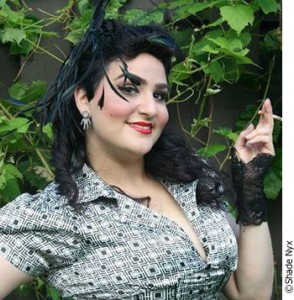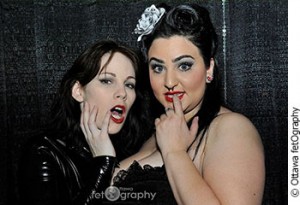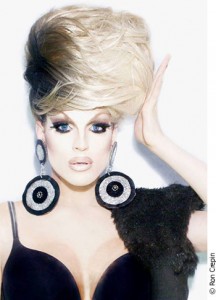Tags
Related Posts
Share This
From daycare to drag: Moonlighting in the capital
Shade Nyx stands outside the burlesque venue where she’s performing and takes a drag out of the cigarette in her hand, which is strictly a social habit, careful not to get any ash on the leather and latex of her costume. Her leather corset is done up tightly, emphasizing a curvy figure; she has fishnets on her bare legs and a dog collar with matching leash on her neck. Looking over, she spots a familiar face from earlier that day: a teacher at the daycare where she picked up the neighbourhood kids she babysits after school. “Oh, hey, Roseanne!” she calls out — casually sparking the conversation that will lead to her current work as a supply daycare teacher (in addition to her day work as a make-up artist at Sephora and moonlighting as a fetish burlesque dancer at night). Most would find it exhausting to divide their lives into three different worlds, but it’s much easier when the three employers all know about each other, and even better when they don’t care.
“Shade Nyx” is her stage name, of course (nyx meaning “night” in ancient Greek), and is the name that she requests be used in this article. Currently she is with Bourbon & Spice, a cabaret-style burlesque troupe that performs in clubs and bars around Ottawa. One of the seven burlesque troupes occupying Ottawa right now, Bourbon & Spice is notable for placing theatrics and story elements above the blatant stripping associated with burlesque.

Betty Page meets Dita Von Teese? Shade Nyx’s style smoothly combines Victorian Goth and old Hollywood.
Corsets can still fly open to reveal elaborate pasties, but there is always a story around it. Shade describes herself as the “kinkster” among the four members of the troupe. “I’m definitely the fetish girl. My audience is geared towards the kink-positive, LGBT-friendly people.” When a particular number in the show calls for whips, chains or ropes, that’s when Nyx really takes center stage.
This is evident amongst the thousands of friends, fans included, on her Facebook page, which she uses both personally and professionally. Regardless of whether they are friends and family or coworkers from either Sephora or the daycare, they can see her whole story on Facebook.
Transparency has worked in her favour so far: Nyx has little fear of reprisal from either of her day jobs because of burlesque. “I have always been upfront with my employers about what I do. I am a performer before anything else,” she says. She admits to not flaunting her burlesque-side needlessly; still, she says, “I don’t censor anything.”
Moonlighting technically means a secondary job that isn’t reported to the government; more often today it refers to a separate night job, done on the side, perhaps implying something secretive and indecent. It is the stereotypical notion of living a dual life: a housewife hosting brunch on the veranda by day and being a paid dominatrix in leather by night.
For Nyx, though, there is no distinction between the two, no separation between what could be two people. “I don’t think there is anything wrong with it. It’s all about the attitude that you have. If you’re gonna act like it’s your dirty little secret, then people will think you’re a freak.”
A progressive way of thinking?
A couple of decades ago, you’d be hard-pressed to find that kind of optimism in a smaller government city like Ottawa. Working as a burlesque dancer, drag queen or any job in the adult night life was a guarded secret, the same as any taboo. Fortunately for Nyx, taboos break down over time, even in traditionally conservative towns.
‘My audience is geared towards the kink-positive, LGBT-friendly people.’ — Shade Nyx

Nyx onstage with Michelle Kestrel Cote. “We do this for the attention. We want people to look at us.”
The judgement, however, may still linger. Kimberly Tessier works as a make-up artist with Nyx at Sephora; while fully supportive of her colleague and friend, Tessier isn’t convinced everyone is so understanding. “I think people care, for sure,” she says. “I’m from a federal government background, and I think more than [Shade] realizes, people have a lot of judgment about what others do outside of work.”
Yet this pragmatic perspective is apparently not shared by all. Chris Seabrook, Shade Nyx’s boyfriend of four years, received a degree in anthropology at Carleton, later coincidentally taking an interest in sexual subcultures. He believes that Canadians as a whole might just be too indifferent to bother caring about what their neighbours and co-workers do on Friday night.
“I think in Canada we don’t have a lot of –isms,” he says, fingers twisting his blond dreadlocks in thought. “There are some people who are truly racist, sexist or homophobic — it’s out there — but most people really aren’t. Some might act that way because they think they should, but really they don’t give a damn. It’s just not relevant to anything.”
However, indifference doesn’t seem to stop misconceptions from remaining prevalent, especially regarding adult entertainment. While burlesque might be misunderstood, drag has arguably suffered the worst misconceptions, specifically about those who refer to themselves as drag queens or kings. Ron Crepin, also known by his stage name, Carmella Kature, has been a drag queen in Ottawa for three years. When going by Crepin, he is a hair stylist at an Ottawa salon. Like Nyx, Crepin is very open about his night life: “It’s on my resume; sometimes I speak with clients about it while doing their hair,” he says, “and sometimes they even come to my shows.”
For your entertainment

To fully recreate himself as Carmella Kature, Ron Crepin might begin at 10 a.m and not finish till 11 p.m. Photo by Derek Colin Hille.
Drag is meant to be more exaggeration than imitation, and a testament to one’s creativity and expression. Crepin emphasizes that those who dress in drag aren’t always meaning to be realistic. “To be a drag queen, you need to entertain, and not everyone can be awed by how realistic you look as a woman. You need to go above and beyond, by creating skills and tricks that captivate the audience around you.”
Crepin performs as Carmella Kature almost weekly, largely in gay clubs around Ottawa such as Lookout and Edge, or in other cities when he gets the chance. His shows largely comprise lip sync dance routines to Top 40 singles — yet that may change, now that actual singing has become more popular among drag queens. A single performance can take days to prepare for, including a full day of physical preparation, and can often be quite costly in unrepaid expenses for materials.
Moonlighting jobs like burlesque and drag share two big similarities. The first is that they are jobs that don’t make a lot of money; both Crepin and Nyx say they couldn’t make a living on just the one job. “I’ve been working for three years in drag, and I only make $75 a show,” says Crepin. “You’re really just earning on tips, which is why you have to be a really good entertainer.”
Nyx says she can earn anywhere between five dollars and four hundred dollars for one show, largely depending on outside factors such as the time of year and the amount of publicity done.
The other similarity is that they are both passions, and provide that thrill of the spotlight. It’s this thrill that makes everything else — the energy required, the out-of-pocket expenses, the hazard of some people’s disapproval — worthwhile. “I was talking to a couple of the other girls,” Nyx adds with a smile. “Let’s face it: We do this for the attention. We want people to look at us.”
If that is the objective, then it’s no surprise that artists like Crepin and Nyx won’t split their lives into two parts. As they stand in the spotlight, with the eyes of strangers, friends and even co-workers on them, it must be a thrill to know that the person onstage is who they really are, and not someone hidden away by day.
Home-page photo courtesy of Bold Daniel Photography and Shade Nyx.
What is burlesque?
Burlesque comes from the Italian word burlesco or burla, which means joke. Traditionally just a work meant to make laughter, it has come to define a type of performing art associated with sensuality, often in a comic fashion.
A strong emphasis of burlesque is placed on the “tease” factor. Common misconceptions include associations more with stripping or erotic dancing than theatre.
Burlesque shows often have a story that the performers act out using music and choreography. This can and does include stripping down to near nudity, usually with the use of “pasties” (patches on a woman’s breasts that cover the nipple area, originally used in burlesque to avoid public indecency laws in the 1920s).
Burlesque in Ottawa
Burlesque in Ottawa has actually only been around for 10 years or so, really picking up in popularity and recognition in the last two years thanks to the rise in alternative culture and entertainment in the media. American burlesque dancer Dita Von Teese could be given as an example of this, being put in the spotlight after marrying Marilyn Manson and thus giving burlesque a new mainstream audience. Burlesque has also been featured in Hollywood films such as Burlesque (2010) and Moulin Rouge! (2001) and by artists such as the Pussycat Dolls.
There are only a handful of burlesque troupes located in Ottawa. They are Capital Tease (7 all-female burlesque troupe), Bourbon & Spice (4 mixed-gender burlesque troupe), Browncoats (10 mixed-gender geek-themed or “nerdlesque” troupe), Rockalily (6 all-female burlesque troupe), Mansfield Brothers Vaudeville (3 all-male vaudeville themed troupe).





